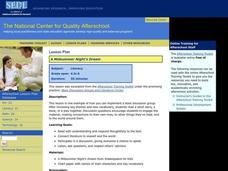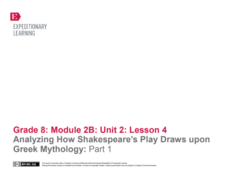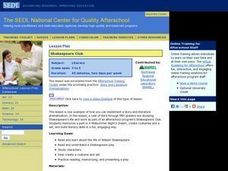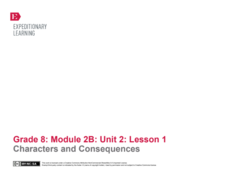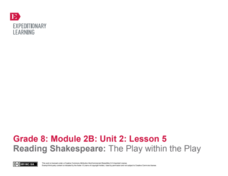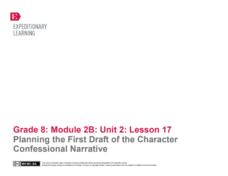Curated OER
Pyramus and Thisbe
Focus on the play embedded in A Midsummer Night's Dream, The Most Lamentable Comedy and Most Cruel Death of Pyramus and Thisbe. All questions in this quiz are concerned with the play-within-a-play and the amateur actors within it.
Curated OER
Guess that Scene: A Review of A Midsummer Night's Dream Through Performance
Students rewrite and perform various scenes from the play, A Midsummer Night's Dream. In groups, they include the main quotes and ideas from their scene, perform it for the class, and identify which scene each group is performing.
Curated OER
A Midsummer Night's Dream
Middle schoolers explore the book A Midsummer Night's Dream. In this literature lesson, students identify main characters and vocabulary words from the text. Middle schoolers participate in a book discussion group.
EngageNY
Analyzing How Shakespeare’s Play Draws upon Greek Mythology: Part 1
Scholars read the story "Pyramus and Thisbe," analyzing word choice, tone, and meaning. They then try to find the gist of the story and discuss how Shakespeare used the myth in his play A Midsummer Night's Dream.
Curated OER
A Midsummer Night's Dream Acts 1-2
Blank verse, stichomythia, soliloquy, allusion, oxymoron, malaprop? Readers of A Midsummer Night’s Dream will need to know these terms to successfully complete a study guide designed for the first two acts of Shakespeare’s comedy. The...
Curated OER
The Bard, the Globe, the Midsummer Night's Dream
Students complete a unit of lessons to learn about William Shakespeare and the Globe Theatre. In this William Shakespeare lesson, students complete 7 lessons of activities to study William Shakespeare, the Globe Theatre, and the play 'A...
Curated OER
I WILL NOT HEAR THAT PLAY: PERFORMING A DUMB SHOW
Learners perform a "dumb show" based on a short passage from either A Midsummer Night's Dream or King Lear. This technique allows students to explain the action taking place on stage and the variety of different ways that action can be...
Curated OER
Shakespeare Club
Students explore literature dramatization. In this Shakespeare lesson, students discuss the characters from the play A Midsummer Night's Dream and construct costumes and a set.
Curated OER
A Midsummer Night's Dream
Students explore the world of love and magic in William Shakespeare's A Midsummer Night's Dream. Comparisons are made to the life experiences of the reader as love's portrayal in contemporary situations are analized.
Curated OER
"Such Affection Move": Finding Staging Clues in A Midsummer Night's Dream
Students perform various scenes from the play, A Midsummer Night's Dream. They examine and discuss the text and stage directions, then perform their scenes in small groups for the class.
EngageNY
Text to Film Comparison: Bottom the Fool
Pretty ugly, jumbo shrimp. Oxymorons are awfully good! Scholars reread Act I, scene 2 from Shakespeare's A Midsummer Night's Dream while participating in a drama circle. Next, they begin working on anchor charts to dissect Shakespeare's...
EngageNY
Author’s Craft: The Poetry of the Play
Feel the rhythm! Pupils begin reading Act 2, Scene 1 of Shakespeare's A Midsummer Night's Dream as they continue participating in a drama circle. With discussion, they examine Shakespeare's use of rhyme, rhythm, and meter, analyzing how...
EngageNY
Reading Shakespeare: Understanding Shakespeare’s Language
Pupils participate in a drama circle to read Shakespeare's A Midsummer Night's Dream aloud. They work with partners to discuss Shakespeare's use of language and analyze how specific lines of dialogue within the play help propel the...
EngageNY
Characters and Consequences
Scholars consider how dialogue reveals aspects of a play's characters as they read Shakespeare's A Midsummer Night's Dream and complete a written conversation note-catcher. Additionally, pupils participate in an I Have/Who Has jigsaw...
EngageNY
Analyzing the Resolution of the Play: World Café Discussion
It's time to get active! Scholars participate in a World Café protocol to promote discussion and leadership. They leave their seats and move from group to group to discuss critical questions related to their read-aloud of Shakespeare's A...
EngageNY
Reading Shakespeare: The Play within the Play
Scholars continue reading the Greek myth "Pyramus and Thisbe," analyzing why it was written into Shakespeare's A Midsummer Night's Dream. Next, they complete a Venn diagram to compare the two texts.
EngageNY
Analyzing How Shakespeare’s Play Draws upon Greek Mythology: Part 3
How do the narrative and play versions of the myth "Pyramus and Thisbe" affect meaning? Scholars reread Act 5, Scene 1 from Shakespeare's A Midsummer Night's Dream and compare its structure to "Pyramus and Thisbe." Next, they use a...
EngageNY
Leaving the Play: All’s Well That Ends Well
How does Shakespeare develop the theme of control in A Midsummer Night's Dream? Using the resource, scholars analyze the theme of parental control in the play and the Greek myth "Pyramus and Thisbe." Next, they talk to partners to...
EngageNY
Analyzing the Model Essay: Studying Argument
Scholars begin writing an argument essay based on Shakespeare's A Midsummer Night's Dream. They read and analyze a model essay, considering the author's thinking before writing it.
EngageNY
Writing an Argument Essay: Evaluating the Model and Crafting a Claim
Pupils prepare to write argumentative essays based on Shakespeare's A Midsummer Night's Dream. They begin weighing evidence and crafting claims for their writing about control.
EngageNY
Writing an Argument Essay: Planning the Essay
Pupils use a helpful resource to begin a Writing Improvement Tracker, developing awareness of their writing strengths and challenges. Additionally, they continue planning their argument essays about Shakespeare's A Midsummer Night's...
EngageNY
End of Unit 2 Assessment, Part 1:Drafting the Argument Essay
An informative resource instructs pupils on how to write their essay drafts about the theme of control in Shakespeare's A Midsummer Night's Dream. Next, scholars complete an Exit Ticket, listing their three favorite characters from the...
EngageNY
Planning the First Draft of the Character Confessional Narrative
Scholars read and analyze a model character confessional narrative to help guide their writing. Then, they plan the first draft of a character confessional based on Shakespeare's A Midsummer Night's Dream.
EngageNY
Mid-Unit Assessment: Author’s Craft: Analyzing Shakespeare’s Craft: Part 2
Annoyed or bewitched—how does an author's word choice affect a text? Scholars begin the instructional activity by analyzing word choice in Shakespeare's A Midsummer Night's Dream. Next, learners take a closer look at the narrative...




